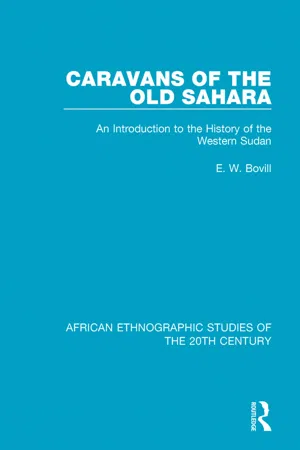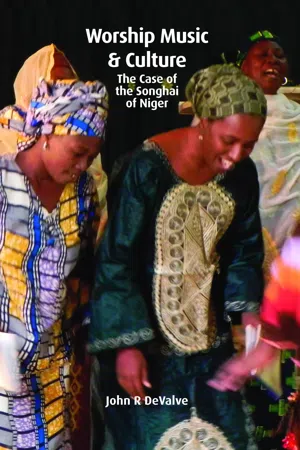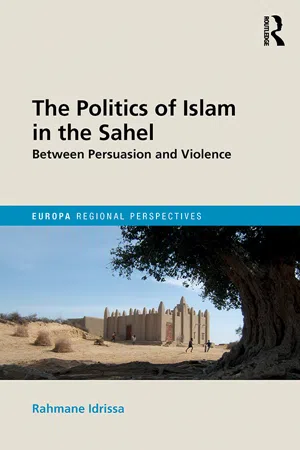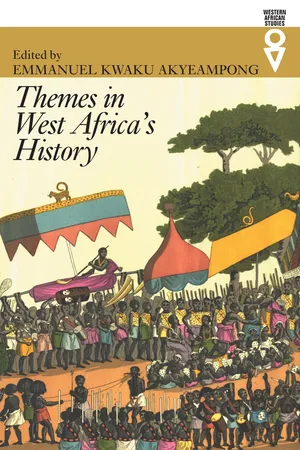History
Mali Empire
The Mali Empire was a powerful state in West Africa from the 13th to the 16th century. It was renowned for its wealth, trade in gold and salt, and the legendary leadership of Mansa Musa. The empire's capital, Niani, was a center of culture, learning, and Islamic scholarship, making it a significant influence in the region.
Written by Perlego with AI-assistance
Related key terms
6 Key excerpts on "Mali Empire"
- eBook - ePub
Caravans of the Old Sahara
An Introduction to the History of the Western Sudan
- E. W. Bovill(Author)
- 2018(Publication Date)
- Routledge(Publisher)
VIIMALI
‘The people of this region excell all other Negros in witte, ciuilitie, and industry.’—LEO AFRICANUS .T HE virile peoples of the Western Sudan have always been distinguished for commercial enterprise, martial ardour, and aptitude for the art of government. From the happy combination of these qualities there sprung a number of political states to which the grandiose style of empire is often loosely assigned. None, however, can challenge the fairness of its application to the great Mandingo kingdom which is known as the empire of Mali or Mande, and is sometimes called the Mellestine.Mali was distinguished above other Sudanese states by its great territorial extent, and by the prestige which attached to its name, not only in Africa but also in Europe. Its wide recognition as a power was largely due to the regular observance by its rulers of the religious duty of the Hadj, which resulted in the formation of many foreign friendships. The trade of the empire was greatly stimulated by these far-flung associations and attracted to the capital all manner of foreign merchants to whose reports may probably be traced the keen interest which, in later years, Christians, especially the Portuguese, showed in the Mandingoes.The empire of Mali is a subject on which we are unhappily very ill informed, our knowledge being practically limited to fragments scattered through the writings of a handful of Arab authors, of whom Ibn Battutà was the only one to visit the Sudan. Our great need is for a chronicle written by a native of the country, similar to Es Sadi’s invaluable history of Songhai, and till some such record comes to light our knowledge will be limited to the roughest outline of its story.In its origin Mali was a small Mandingo kingdom extending eastwards from the upper Bakhoy across the Niger. The capital was Jeriba, where extensive ruins have been found.1 Of its history before the thirteenth century all we know is that one of its rulers, named Baramendana, was converted to Islam by an uncle of Yusuf ibn Tachifine* in the early days of the Almoravid movement. Baramendana made a pilgrimage to Mecca and thus set an example which was regularly followed by his successors.2 - eBook - ePub
- Frederick Cooper(Author)
- 2014(Publication Date)
- Harvard University Press(Publisher)
5 But its growth and continued strength stemmed from control of trade routes linking Sahelian territories across the desert to North Africa and the Mediterranean world.Michael Gomez, who has embarked on a reexamination of the Islamic empires of West Africa, points out that Mansa Musa, the young king of Mali at the turn of the fourteenth century, knew about the Almoravid and Almohad empires of North Africa and about the Mamluks who ruled Egypt.6 The title mansa can be translated as emperor. Mali was an empire among empires, a multiethnic polity. The emperor not only distributed the resources of trade and conquest to followers, but put together a power base independent of his own society and especially its elite members. Slaves were crucial to his rule, serving in the palace and administration, including the farba , a slave who was the head of the royal household and chief of the other slaves.7 The seemingly incongruous position of a slave who had been torn away from his community of origin and yet exercised power in the polity of his captor or purchaser was in fact the key to his role in imperial administration, one practiced to a high degree in the earlier Abassid Caliphate and later in many African kingdoms. The slave-administrator had no authority or status other than that derived from the monarch’s patronage. Such a situation focused the mind.Mali expected loyalty, tribute, and military service from the communities and territories that had been incorporated into it, but left its provinces to largely run themselves. Like other empires—from Rome to China—it pulled in people to work on large-scale state projects. It used externally derived labor to expand the center’s control of agricultural production, settling slaves in villages to supply the royal granaries. Imperial power promoted a differentiated society: the royal household with its administrator-slaves, agricultural slaves, army, occupational castes, peasants.8 - eBook - ePub
- (Author)
- 0(Publication Date)
- Rough Guides(Publisher)
Mali - Part 1
Mali - Part 1 |Introduction and Basics
Historically, geographically and from the point of view of the traveller, Mali is West Africa’s centrepiece. Long a bridge between the north and the south – the Sahara and the forest – the area outlined by the butterfly shape of the modern country formed the meat of three great empires, the oldest of which was ancient Ghana, which flourished as early as the third century. The region’s location on the main caravan routes and the banks of the Niger River later fuelled the rise of the powerful Mali and Songhai states, which lasted until the sixteenth-century invasion by Morocco. The political stability and unity of previous centuries was never recovered again.Reminders of Mali’s great past are remarkably intact. Camel caravans still make their way from salt mines in the Sahara to Timbuktu, where you can visit a fourteenth-century mosque built when the town was one of the world’s most prestigious centres of learning and culture. Wooden pinasses continue to carry their cargo along the river from here to Djenné – a great commercial town that spawned numerous technical innovations including the Sudanic style of architecture now common throughout the region. Boats also ply the river to the Sahelian town of Gao – formerly the capital of the Songhai Empire and final resting place of the Askia kings.Tempering the romance of the country’s opulent past is the more immediate spectre of poverty, widely evident even in Bamako. Apart from a little gold, Mali lacks substantial mineral resources and is almost wholly dependent on its animal and agricultural production (especially its important cotton crop), rendering its droughts all the more devastating. In the early 1980s harvests failed almost entirely, and as much as three-quarters of the livestock was lost. People moved from the countryside to already crowded towns and, having lost everything, nomads were forced into a sedentary lifestyle and a cruelly inadequate wage economy. There has been reasonable economic growth in recent years, limited as ever by the vagaries of the international market for the country’s main crop, cotton - eBook - ePub
- John R DeValve(Author)
- 2020(Publication Date)
- Regnum(Publisher)
The West African Sudan was the crucible for three great kingdoms that arose successively between AD 300 and AD 1600. These kingdoms, largely forgotten and not to be confused with any modern nation-state, are known to historians as Ghana, Mali, and Songhai (see Map 2-2). Ghana formed around AD 300 and reached the height of its power and influence around 1050. After several generations of warfare, its successor Mali rose to prominence in 1230 and dominated the western savannah for two centuries. The third kingdom, the Songhai, endured only 130 years as a great empire (1464 to 1591). Nevertheless, E Jefferson Murphy calls it ‘the pinnacle of development for Sudanic civilization.’ 3 Each of the three kingdoms developed sophisticated political organizations and advanced civilizations. They were wealthy, and few people went hungry. Some learned to read and write, and most lived in security. Scholars have argued that these civilizations were at times equal or superior to contemporary European civilizations. 4 Their prosperity rested on commerce, particularly the lucrative trans-Saharan trade in gold, salt, and slaves. They became the middlemen for the trade between the peoples of the forests to the south and the peoples of North Africa. The Niger River served as a conduit for goods coming from and heading south, and the trans-Saharan camel caravans for goods coming from and heading north. Great cities such as Kumbi Saleh, Walata, Jenné, Timbuktu, and Gao developed to facilitate this commerce. Not only were these cities the terminal ‘ports’ for trade but they also boasted centers of learning where scholarship flourished and served as centers for the propagation and spread of Islam throughout the region. 5 Songhai Sources and Origins Written and oral sources are limited for the history of the Songhai, and they do not agree on every point. Many details are obscure - eBook - ePub
The Politics of Islam in the Sahel
Between Persuasion and Violence
- Rahmane Idrissa(Author)
- 2017(Publication Date)
- Routledge(Publisher)
Mali is today one of the poorest countries in West Africa, but its territory corresponds to what used to be the wealthiest section of the region, the western savannah. In historical times, the savannah was the most densely populated part of the region. From west to east, the Manden, the Mogho and Hausaland succeeded each other, with the Manden and its surrounding region enjoying the most privileged situation. It is here that both the Senegal River and the Niger River take their source and receive their early upriver tributaries, with the Niger Valley playing the most important part in the history of Mali. After gushing from highlands in what is now Guinean territory, the river courses due north parallel to the Bani River, which joins it in a spectacular inland delta dotted with large bodies of water before encountering the desert. It then bends southwards and digs its way south-east through sand dunes. In very ancient times, as there was less desert, the Niger was sustained by tributaries flowing from northern massifs and was thought to have captured the stream of another river that emptied north of the inland delta – the explanation given for its unique crescent shape. As late as the Songhay era, what is now northern Mali was greener than it is today, certainly around Gao. Besides farming, cattle-rearing and fishing, the region also afforded large-scale iron, gold and salt mining and developed related productive activities that served as the basis for the exchange economy that took shape under the imperial states of Ghana, Mali and Songhay.If the Western Sudan was thus historically the wealthiest part of West Africa, the period that forms the ‘origins of contemporary Mali’ (to paraphrase the title of Hippolyte Taine’s celebrated work about France)1 was a troubled watershed in its history. In 1591, the translatio imperii that had guaranteed regional peace and security since the time of Ghana came to an end with the fall of Songhay. A troubled period ensued for much of the 17th century, during which the imperial area broke up into its component parts. Senegambia, which had been an economic province of the larger Western Sudan under the imperial states, developed its own commercial system turned towards the Atlantic, as we have seen in Chapter 4 on Senegal. The desert-side economy, dominated by Timbuktu under Songhay, continued in a much weakened form, having been hit both by the collapse of law and order and the redirection of trade routes towards Senegambia. The Middle Niger Valley, which had rapidly eluded the control of the Arma, the Moroccan settlers who integrated Songhay society as its new ruling élite, was groping for a new order. However, Jenne, the centre of the regional exchange economy, was not brought down.Then, in the period from about 1660 to 1860, a new order prevailed from Timbuktu to the Upper Senegal Valley through the Middle Niger Valley. This was begotten first by the establishment of Bambara hegemony around the states of Segu and Kaarta and later by the rise of a Fulani religious state, the Diina of Hamdullahi in the inland delta, in the early 19th century. Even the desert country north of Timbuktu, known as ‘Azawad’, came under some fragile order thanks to the action of the Kunta tribe, a Zwaya group influential across the western and central Sahara. (The Zwaya are the clerical group of the Sanhaja Berbers we encounterd in Chapter 4.) The new order provided for a kind of geopolitical balance between Islam and animism, the first dominant in the north, the second in the south – and it appears as the embryo of contemporary Mali. However, if it wasn’t shattered, it was at least badly damaged by the invasion of jihadist Al Haji Umar Tall in 1861–1864, with important implications for the relations between Muslims and animists across what is now southern Mali leading into the colonial era. - eBook - ePub
- Emmanuel Kwaku Akyeampong(Author)
- 2006(Publication Date)
- Ohio University Press(Publisher)
In conversation resulting from this performance, the learned elders of Fadama mentioned that results of Kolonkan’s curse are manifest in the cases of weakness among mansaw of the Mali Empire. The consequences they remember correspond in kind to various thirteenth- and fourteenth-century disruptions mentioned in the Arabic sources, including various usurpations, the insanity of one Malian emperor, and the tyranny of another. 41 For modern times, the elders cite the 1968 overthrow of the Republic of Mali’s first President Modibo Keita, as well as recent power struggles among candidates and regimes of other countries containing large Mande populations. Conclusion In this chapter we have seen that the West African Manding peoples’ collective view of what is worth remembering from the distant past is considerably different from European notions of historically significant events. According to European academic standards, the very existence of ancestors who, according to Manding perceptions, performed empire-building deeds is scarcely credible. Nevertheless, owing to the richly textured imagery and poetically narrated stories of ancient heroes and heroines passed along by generations of specialists in the oral arts, the ancestors maintain an ongoing presence in the everyday consciousness and affairs of local villagers and townspeople. Indeed, all people who are known by the ancient family names derive their fundamental identities from characters described in the epic traditions. The legendary deeds performed by larger than life forebears interacting with formidable denizens of the spirit world provide an idealized paradigm for social relationships and behavior in today’s Manding societies. Recommended Reading Austen, Ralph A
Learn about this page
Index pages curate the most relevant extracts from our library of academic textbooks. They’ve been created using an in-house natural language model (NLM), each adding context and meaning to key research topics.





